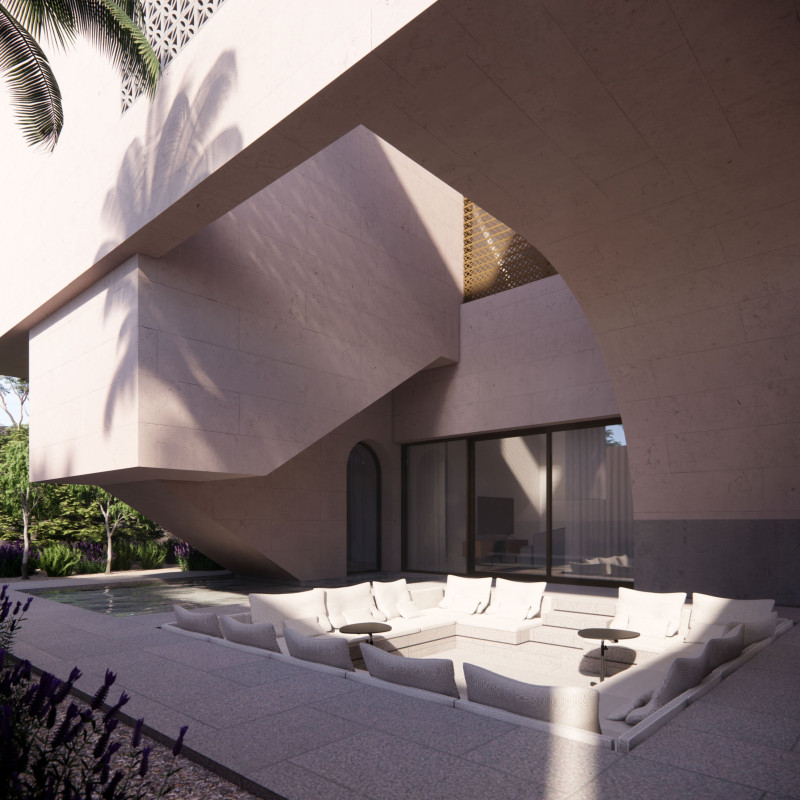5 key facts about this project
This architectural design stands out for its innovative approach to space utilization. The layout encourages fluid movement throughout the interior, promoting an interactive experience for occupants. The central atrium is a notable feature, acting as a beacon of natural light that permeates the entire building, facilitating a sense of openness and accessibility. Surrounding the atrium, various functional areas are strategically placed to enhance usability and social interaction. The careful arrangement of spaces not only serves their intended purposes but also cultivates a welcoming atmosphere, encouraging collaboration and engagement among its users.
Materiality plays a pivotal role in the project, with a selection of materials that reflect both durability and aesthetic appeal. The use of natural stone, glass, and sustainable timber creates a tactile experience that resonates with the building's surroundings. Natural stone cladding not only enhances the structural integrity but also provides a visual connection to the earth, complementing the landscape. The extensive use of glass throughout the design invites the exterior environment inside, blurring the boundaries of indoor and outdoor spaces. Sustainable timber accents add warmth and texture, contributing to the overall sensory experience of the building.
The roof design is particularly noteworthy, characterized by its angular forms that not only serve aesthetic purposes but also enhance functionality. This feature allows for effective rainwater drainage while also providing shelter to outdoor spaces below. The interplay of light and shadow across the roof’s surface creates dynamic visual effects throughout the day, adding depth to the design. Furthermore, this roofing strategy integrates renewable energy solutions, utilizing solar panels that align with the project’s commitment to sustainability.
Landscaping is another significant aspect of the project, thoughtfully designed to complement the architectural features while enhancing the user experience. Native plant selections reduce maintenance needs and promote biodiversity, linking the building to its environmental context. Pathways and seating areas are cleverly integrated, inviting users to engage with both the building and its landscape. The outdoor spaces serve as extensions of the indoor areas, facilitating seamless transitions and offering opportunities for various social activities.
Unique design approaches in this project include the incorporation of flexible spaces that can adapt to different functions as community needs evolve. Rooms can be reconfigured for various events, from workshops to social gatherings, reflecting an understanding of the dynamic nature of communal life. This adaptability is a defining characteristic of contemporary architectural design, ensuring longevity and relevance in a rapidly changing environment.
Sustainability is deeply embedded in the project's ethos, considering both environmental impact and user well-being. The design employs passive heating and cooling strategies, optimizing energy efficiency while maintaining occupant comfort. Natural ventilation systems enhance air quality, minimizing reliance on mechanical systems. Water conservation measures, such as rainwater harvesting, contribute to the project’s overall sustainability goals.
Throughout this architectural project, the thoughtful integration of function and design elements coalesce to create a remarkable environment that caters to a diverse community. The project not only functions as a physical space but also amplifies social interactions, encourages environmental stewardship, and stands as a testament to contemporary architectural practice. The careful consideration of materiality, innovative use of space, and sustainability principles come together to form a cohesive design narrative that deserves exploration.
For those seeking a deeper understanding of this architectural endeavor, examining the project presentation which includes architectural plans, architectural sections, and various architectural designs will provide valuable insights into the intricacies, challenges, and achievements that define this exemplary project. Exploring these elements can enrich your appreciation of the architectural ideas that underpin this design and its unique responses to contemporary needs.


























